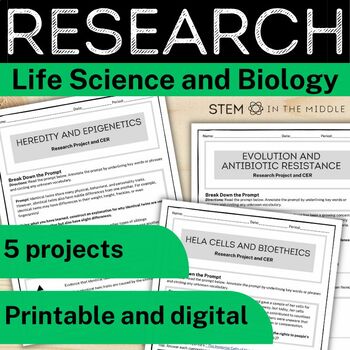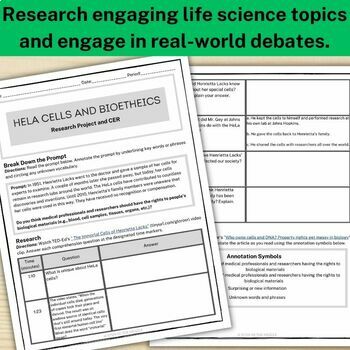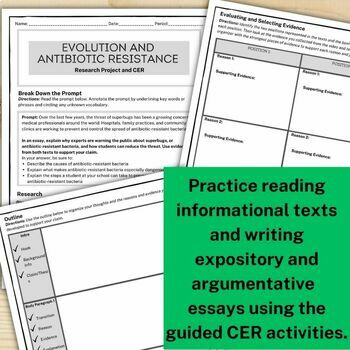Life Science and Biology Research Projects and Claim Evidence Reasoning Practice
- Zip
- Google Apps™
- Easel Activity

What educators are saying
Products in this Bundle (5)
Description
Are you looking for independent research projects for life science or biology? Maybe you want to incorporate more reading and writing in your science class? Introduce your students to real world discoveries and amazing phenomena with these low-prep research projects. Students will gather information from text and video sources. Then they will craft argumentative or explanatory essays using the CER format.
Each project meets life science, reading, and writing standards. Students begin each project with gathering evidence from a video and an article. The sources introduce students to the real world phenomena and life science concepts. Then students create a claim in response to the provided prompt and gather evidence to support their claim. This information is compiled in an easy-to-use graphic organizer. Finally, students outline their ideas and produce an essay to justify their position on the provided topic.
The research projects are independent and low-prep. They can be used for teacher-led lessons, but these resources also make great distance learning activities, ELA and STEM cross-curricular projects, STEM sub plans, holiday break packets, or extra credit assignments. Grab this resource today to save your planning and prep time, while knowing your students will be engaged and inspired while learning about real-world science!
_________________________________________________________________________
What’s included in the life science research project bundle?
- Evolution and Natural Selection of Antibiotic Resistant Bacteria Research Project:In this research project, your students will learn about selection pressures and the dangers of antibiotic-resistant bacteria. This project will help your students meet NGSS MS-LS4-4, MS-LS4-5 and HS-LS4-5.
- Fossil Record Research Project: In this fossil record research project, your students will learn about fossilized whale remains discovered in a Chilean desert. This resource will help your students meet NGSS MS-LS4-1.
- Genetics and Heredity Research Project: In this research project, your students will learn how our genes interact with the environment to shape who we are. This project will help your students meet MS-LS1-5.
- Henrietta Lacks and Bioethics Research Project: Help your students learn about Henrietta Lacks, HeLa Cells, and the property rights of biological materials with this bioethics research project.
- Pollinator Bees and Ecology Research Project Grab this pollinator research project, and inspire your students to “save the bees!” and advocate for pollinator-friendly environmental policies. This resource will help your students meet NGSS MS-LS2-4.
Each life science research project described above also has:
- Detailed teacher notes to assist with facilitation and lesson planning
- Printable PDF, Easel, and Google versions of the student worksheets
- Embedded links to quality background research video clips and an article
- Video guide and annotation key to support students with gathering evidence
- Graphic organizers to support the CER scientific writing process
- Easy-to-use grading rubric and answer key
Materials needed:
- Digital or printable copies of the student worksheets
- Copies of the background research articles or a device with internet access to read on
- A teacher computer with internet access or student devices to watch the video clips
________________________________________________________________________
How can the life science research project be used in your classroom?
- Meet reading, writing, and science standards
- Introduce your students to real-world science discoveries and phenomena
- Use as a low-prep life science or biology sub plans
- Assess your students understanding of life science concepts
- Create a cross-curricular ELA and Science projects
- Practice scientific reading and writing with claim, evidence, reasoning (CER)
- Introduce real-world STEM disciplines and professions
- Develop 21st-century STEM skills, such as communication and critical thinking
- Assign extra credit and extension activities
_________________________________________________________________________
Feedback
Did you know you can earn credit towards future TPT purchases by leaving a review? If you download this product, please come back and leave a review at the product page or through “My Purchases” under “My Account” at TPT
_________________________________________________________________________
Product Recommendations
If you liked this product, check out:
_________________________________________________________________________
Let’s stay in touch!
If you have any questions about this product or my store, please send me an email. I’d love to hear from you! Follow me on TPT to learn about new products, sales, and freebies!





